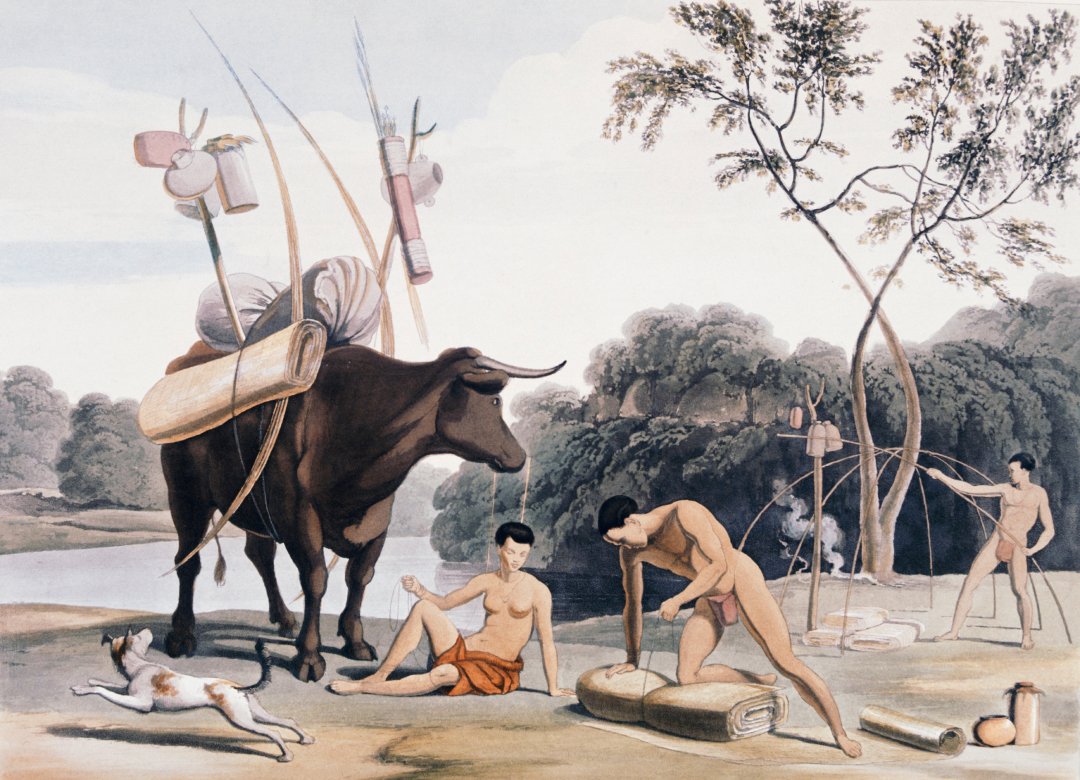Mamre Moravian Mission Station – Tracing the history of the Khoekhoen and formerly enslaved people
Image: Mamre Moravian Heritage Committee.
History
Mamre’s history is a story of colonisation, resistance, and adaptability. The town and its preserved Moravian Mission Station stand today to tell the story of the Khoekhoen who originally inhabited the area, as well as emancipated enslaved people who came to settle here in search of a better life.
To this day, the people of Mamre include descendants of the Khoekhoen and formerly enslaved people.
Image: Genadendal 18th century, Unknown artist, William Fehr Collection (B8), Iziko Museums of South Africa
The Mamre Moravian Mission Station
The Moravian Church is one of the oldest denominations within the Protestant religion and came to South Africa from Germany in the early 18th century. The Moravian Mission Station at Mamre was the second one to be established in the Cape with the first being Genadendal in the Overberg.
Image: Korah/Koranna preparing to move (1831). Samuel Daniell (1775-1811), William Fehr Collection (H10), Iziko Museums of South Africa
Groenekloof cattle and military outpost
The farm on which the Mission was established was known as Groenekloof and was later renamed Mamre in 1854. Yet the area was originally home to a Khoekhoe group, the Cochoqua, who grazed their cattle on this fertile land.
In the early 1700s, the Dutch East India Company, better known under its Dutch name Vereenigde Oost Indische Compagnie (VOC), permitted farmers to graze their cattle in this area.
The Longhouse. Image: Jose Romeu de Abreu
Between 1701 and 1791, a military outpost was also established to deal with the problems arising from contact between the farmers and the indigenous Khoekhoe inhabitants. The military outpost and the buildings that were established there were called “De Kleine Post”.
These buildings still exist today and form part of the Moravian Mission Station in Mamre.
The Long House, dating back to 1697, was used by the VOC as military barracks.
The Parsonage. Image: Mamre Moravian Heritage Committee
The Parsonage was also built as part of the military outpost of the VOC and was home to Willem van der Stel who came to Groenekloof to establish the military outpost. It is the oldest building on the Mission Station with the gable dating back to 1679.
Image: Mamre Moravian Heritage Committee.
The Cookhouse building dates to 1700. It was used as a police station and a jail for a short time, but more recently served as a kitchen in times of festivities.
Image: Missionary settlement at Groenekloof, 1818. Latrobe (1758-1836), William Fehr Collection (H70), Iziko Museums of South Africa
Establishment of the mission station
In 1791, the VOC left the area, and in 1808, after the Cape passed into the possession of the British, De Kleine Post and the adjoining farms were given to the Moravian Church to start a mission station. The adjoining farms included two old Khoekhoen settlements, Louwskloof and Krywagenskraal.
The main purpose of the mission station was to convert the local Khoekhoen to the Christian faith. The location was, therefore, considered very suitable as it contained existing buildings left by the VOC and an already established Khoekhoen settlement as a site for religious work.
Image: Adrian Jonker
The Khoekhoen at the mission station
Hans Klapmuts, Chief of the Cochoqua, and his followers lived on the Louwskloof farm given to the Moravian Church in 1808. Although Hans Klapmuts resisted conversion for 30 years, many of his followers became converts and moved to the mission station.
It was on Louwskloof in 1808 that the first religious service was held in the open for 100 people. Today a memorial can be found on that spot commemorating the place of the first Christian sermon for the Cochoqua.
Image: Missionary Settlement at Groenekloof, 1816, Latrobe (1758-1836), Parliament Collection
The story of Benigna Johannes – the mother of Mamre
Rosetta Klapmuts, Hans Klapmuts’ sister, was one of the first residents at the mission. She took the name Benigna Johannes when she was baptised in 1813. Benigna became Chief of the Cochoqua after the death of Hans Klapmuts and her descendants are still living in Mamre today.
Benigna played an important role in establishing the Moravian mission station at Mamre and her life story was captured in a Moravian Church publication “Benigna van Groenekloof of Mamre” which was published in Afrikaans in 1873. She was relatively well-off and owned a wagon and cattle. She was also generous and allowed the mission station to use her wagon and cattle to collect construction material and equipment for building the church.
Although Benigna moved to Mamre, the Johannes family continued to live on the nearby Louwskloof farm until the early 1970s when they were forcibly removed under apartheid legislation.
The church in the 1930s. Image: National Library of South Africa
The Moravian Church in Mamre
Work on the church in Mamre started in 1808 and was completed in 1818, making it one of South Africa’s oldest churches.
The Church today. Image: Cape Town Museum, Western Cape Department of Cultural Affairs and Sport.
The bell was installed in 1872 and weighs 250 kg. Image: Cape Town Museum, Western Cape Department of Cultural Affairs and Sport.
The Marcusson church organ comes from Denmark and is the original organ. It dates from 1887. Image: Cape Town Museum, Western Cape Department of Cultural Affairs and Sport.
Image: Mamre/Groenekloof (1856), Rev D. W. Suhl, William Fehr Collection (H81), Iziko Museums of South Africa
The arrival of emancipated enslaved people at Mamre
Following the establishment of the mission, Khoekhoen from surrounding areas continued to join the community. However, the majority of newcomers in 1838 were emancipated enslaved people who settled there following the abolition of slavery in the Cape in that same year.
Moravian Church archives show that most of the 700 people who sought permission to settle at Groenekloof between January 1839 and December 1852 were formerly enslaved people. The majority of them came from farms in the Koeberg, Blaauberg, and Malmesbury districts. Some came from as far as Swellendam and Clanwilliam.
Image: Groenekloof Mission Station, circa 1814. James Backhouse, Western Cape Archives (M250)
Close ties between Khoekhoen and the emancipated ‘slaves’
Many of the emancipated ‘slaves’ who settled at Mamre already had a connection to the mission as they had attended church services there. There is also strong evidence of close working and family relationships between free Khoekhoe communities and enslaved apprentices*, who worked together on surrounding farms before the enslaved apprentices were emancipated.
Records show that on 2 December 1838*, Groenekloof held a thanksgiving ceremony to celebrate the end of slavery - an indication of the close links between the Khoekhoe community at the mission and enslaved people at the time.
*Even though slavery was abolished in 1834, slaves in the Cape were forced into a four-year apprenticeship which ended on 1 December 1838.
Mamre Moravian Mission school. Image: Jose Romeu de Abreu
The role of the mission in the lives of Khoekhoen and emancipated slaves
Although life at the mission demanded that people live under the rules and edicts of the Moravian Church, the mission provided a space where families that were broken up by the institution of slavery could re-connect and build a life together.
At the mission station, those who settled there were allowed to learn a trade and farm on mission land. This generally meant more independence and better work than being a permanent farmworker on private farms.
Education was also an important part of the Moravian mission objectives.The first school classes were held in the Parsonage as well as in the Long House. In 1876, a small school was added to the existing buildings.
Image: Mamre Moravian Heritage Committee.
Farming at the mission station
The economy of Groenekloof during the early period was primarily based on subsistence agriculture.
The Old Watermill still stands today and is a testament to the fertile farming land of the area which lies on the edges of the Swartland - the bread-basket of the Western Cape. Donkeys or mules were initially used for threshing and winnowing the wheat before being milled at the Old Water Mill. It dates back to 1844 and was declared a National Monument in 1973.
Moravian Church in District Six. Image: Wikimedia.
Mamre and beyond
As Mamre grew, there was not enough land for all who settled to become independent farmers. Many men turned to seasonal farmwork, while women did domestic work.
Some of the Mamre community also settled in surrounding areas, including Cape Town, to make a living. For many families of Mamre, the ride to Cape Town and back, therefore, became a familiar journey. By 1886, there were so many Moravians from the Cape rural mission stations, especially Mamriers, living and working in Cape Town that the missionaries established the Moravian Hill Church in District Six which still stands today.
Image: Sam Nagy
Mamre today
Over the years Mamre has become an established town, comprising far more than the original mission station. Today, it is only a bus trip away from the Cape Town city centre and it is possible to commute daily between Mamre and the central business district. Many have also found employment in nearby Atlantis.
The Mamre Mission Station remains the property of the Moravian Church and continues to serve the spiritual needs of the community. The complex around the church building was declared a National Monument in 1967 and is a well-known tourist attraction.
“To this day, the people of Mamre continue to celebrate their Khoekhoen and slave heritage. The video below is of an event held at the Mamre Mission Church in 2018 in celebration of the end of slavery. It was held by the Cape Town Museum in partnership with the Mamre Moravian Heritage Committee and the SA Sendingsgestig Museum.”
The descendants of Hans Klapmuts and Benigna Johannes
Chief of the Cochoquas, David Johannes.
Hans Klapmuts was the Chief of the Cochoqua when the mission station was established in 1808. When he died, his sister Benigna Johannes, who had received this name when she was baptised by the Moravian missionaries, became chief of the Cochoqua. She was succeeded by her son, Nataniel Johannes, who passed on the chieftainship to his son Wilhelm, and Wilhelm then passed it onto Pieter Daniel.
Pieter Daniel Johannes was succeeded by his son, William, who died before he could appoint his successor. William’s sister, who still lives in Mamre, advised that David Johannes should succeed William. Today, he is the Chief of the Cochoqua and the Johannes family continues to be prominent members of the Mamre community.
References
Beck, P. 2016. “A short history of Mamre’s Moravian Mission Station”. 4 September. The Heritage Portal. [Available Online: http://www.theheritageportal.co.za/article/short-history-mamres-moravian-mission-station ] Accessed: 28 November 2018.
Ludlow, E. H. 1992. “Missions and Emancipation in the south Western Cape: A case study of Groenekloof (Mamre), 1838-185”. Unpublished Masters’ Thesis [University of Cape Town]. https://open.uct.ac.za/bitstream/handle/11427/21706/thesis_hum_1992_ludlow_helen.pdf?sequence=1
Ward, K.R. 1992. “The road to Mamre: Migration, Memory, and the meaning of community c1900 -1992“ Unpublished Masters’ Thesis [University of Cape Town] https://open.uct.ac.za/bitstream/11427/19006/1/thesis_hum_1992_ward_kerry.pdf
Lucien Le Grange. 1991. Moravian Mission Stations in the Western and Southern Cape: Conservation Study. https://sahris.sahra.org.za/sites/default/files/heritagereports/Moravian%20Mission%20Stations%20in%20the%20Western%20and%20Southern%20Cape%20Conservation%20Study.pdf
Personal Communication, Mamre Moravian Heritage Committee, December 2018.





















